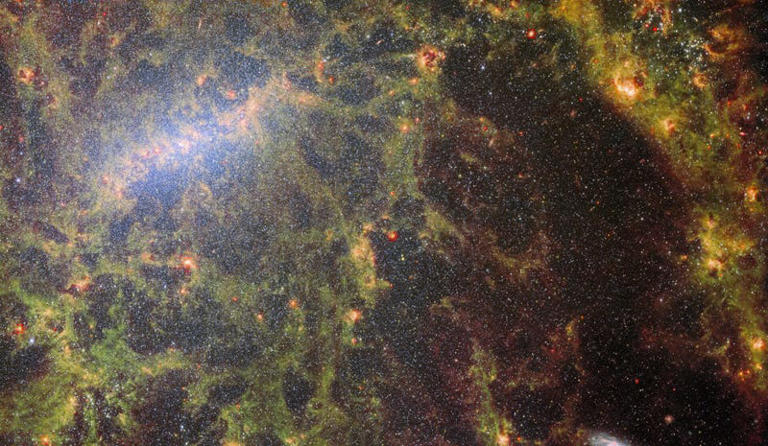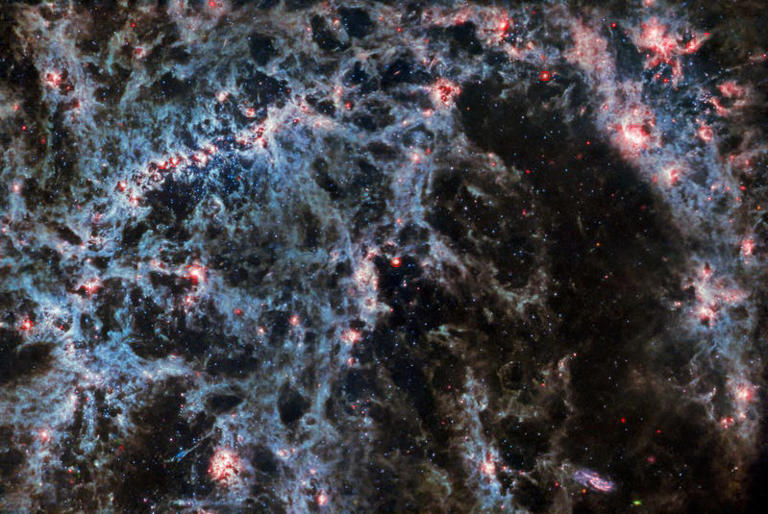Story by Isaac Schultz • Yesterday

NGC 5068, as seen by Webb's MIRI and NIRCam instruments.
© Image: ESA/Webb, NASA & CSA, J. Lee and the PHANGS-JWST Team
NGC 5068, as seen by Webb’s MIRI and NIRCam instruments.
The Webb Space Telescope is on a tear, imaging regions of star formation across the cosmos. Its latest target? The barred spiral galaxy NGC 5068—a bedazzled conglomeration of gas and stars 17 million light-years from Earth.
Launched in December 2021, Webb has been making scientific observations since July 2022. It’s uniquely capable of seeing some of the oldest, most distant light, which it does at infrared wavelengths. Taking data on this ancient light clues astronomers into the formation and evolution of the universe as we know it.
But besides that ancient light, Webb is examining a bevy of cosmic objects, from distant supernovae to planets in our own solar system. Its perceptive vision can cut through clouds of gas and dust that obscure regions of star formation from more veteran telescopes, like the Hubble Space Telescope.
Bit by bit—image by image—the telescope is providing new data about how the universe works. Some of Webb’s coolest and most remarkable images to date can be seen here.
Enter NGC 5068. Sitting in the constellation Virgo, the barred spiral galaxy is filled with yellower dust and fiery regions of gas in Webb’s view. The image is a close-up, showing the galaxy’s core and part of one of its arms. Stars pepper the image’s foreground.
This image is a composite of images taken with two imagers aboard Webb, the Near-Infrared Camera (NIRCam) and the Mid-Infrared Instrument (MIRI). Combining the powers of the two instruments offers a holistic view of the region. The image by NIRCam emphasizes the foreground stars, while MIRI’s image reveals the larger structure of the galaxy, as well as a couple of asteroid trails (which appear as blue-green-red dots).

The same view of the galaxy as seen by MIRI alone.© Image: ESA/Webb, NASA & CSA, J. Lee and the PHANGS-JWST Team
There’s an extensive thought process behind what filters are applied in Webb imaging, and what aspects of each image to highlight when visible light colors are assigned to the infrared wavelengths the observatory takes in. Last year Gizmodo spoke to Webb’s image processors to learn about how they choose what parts of an image to emphasize, and how.
The NGC 5068 image was collected along with images of 18 other star-forming galaxies, which astronomers are combining with existing data on over 40,000 star clusters, nebulae, and molecular clouds taken by Hubble, the Very Large Telescope, and the Atacama Large Millimeter/submillimeter array.
Taken altogether, these catalogs are deepening astronomers’ knowledge of how stars (and what kinds) take shape in different recesses of space. With Webb’s perceptive gaze, scientists are cutting through the gas and dust that has literally clouded understandings in the past.
NGC 5068, as seen by Webb’s MIRI and NIRCam instruments.
The Webb Space Telescope is on a tear, imaging regions of star formation across the cosmos. Its latest target? The barred spiral galaxy NGC 5068—a bedazzled conglomeration of gas and stars 17 million light-years from Earth.
Launched in December 2021, Webb has been making scientific observations since July 2022. It’s uniquely capable of seeing some of the oldest, most distant light, which it does at infrared wavelengths. Taking data on this ancient light clues astronomers into the formation and evolution of the universe as we know it.
But besides that ancient light, Webb is examining a bevy of cosmic objects, from distant supernovae to planets in our own solar system. Its perceptive vision can cut through clouds of gas and dust that obscure regions of star formation from more veteran telescopes, like the Hubble Space Telescope.
Bit by bit—image by image—the telescope is providing new data about how the universe works. Some of Webb’s coolest and most remarkable images to date can be seen here.
Enter NGC 5068. Sitting in the constellation Virgo, the barred spiral galaxy is filled with yellower dust and fiery regions of gas in Webb’s view. The image is a close-up, showing the galaxy’s core and part of one of its arms. Stars pepper the image’s foreground.
This image is a composite of images taken with two imagers aboard Webb, the Near-Infrared Camera (NIRCam) and the Mid-Infrared Instrument (MIRI). Combining the powers of the two instruments offers a holistic view of the region. The image by NIRCam emphasizes the foreground stars, while MIRI’s image reveals the larger structure of the galaxy, as well as a couple of asteroid trails (which appear as blue-green-red dots).

The same view of the galaxy as seen by MIRI alone.© Image: ESA/Webb, NASA & CSA, J. Lee and the PHANGS-JWST Team
There’s an extensive thought process behind what filters are applied in Webb imaging, and what aspects of each image to highlight when visible light colors are assigned to the infrared wavelengths the observatory takes in. Last year Gizmodo spoke to Webb’s image processors to learn about how they choose what parts of an image to emphasize, and how.
The NGC 5068 image was collected along with images of 18 other star-forming galaxies, which astronomers are combining with existing data on over 40,000 star clusters, nebulae, and molecular clouds taken by Hubble, the Very Large Telescope, and the Atacama Large Millimeter/submillimeter array.
Taken altogether, these catalogs are deepening astronomers’ knowledge of how stars (and what kinds) take shape in different recesses of space. With Webb’s perceptive gaze, scientists are cutting through the gas and dust that has literally clouded understandings in the past.
No comments:
Post a Comment